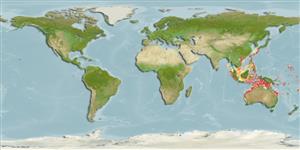Environment: milieu / climate zone / depth range / distribution range
Ekologi
marina revassocierade; djupintervall ? - 82 m (Ref. 11356). Tropical
Western Pacific: Philippines and Western Australia.
Size / Vikt / Age
Maturity: Lm ? range ? - ? cm
Max length : 5.9 cm SL hane/ej könsbestämd; (Ref. 11356)
Short description
Bestämningsnycklar | Morfologi | Morfometri
Taggstrålar i ryggfenan (totalt) : 8; Mjukstrålar i ryggfenan (totalt) : 9; Taggstrålar i analfenan: 2; Mjukstrålar i analfenan: 8; Ryggkotor: 24. Redescription of the holotype: dorsal fin, 2 supernumerary spines on first pterygiophore, first spine missing; anal fin with 1 supernumerary spine on first pterygiophore, second spine in serial association with first pterygiophore, the following ray is branched; principal caudal rays 9+8, branched caudal rays 8+7; upper gill arch with 3 rudiments and 5 developed gill rakers, lower gill arch without rudiments and 19 developed gill rakers; villiform teeth in several rows on the premaxilla; 1 row on the dentary, 1 on the palatine and vomer; none on ectopterygoid, endopterygoid or basihyal; scales none; hypurals 3 and 4 partially fused, hypurals 1, 2 and 5 free; one pair of slender uroneurals; 3 epurals; a free parhypural; 3 supraneurals as 0/0/0/ in association with anterior neural spines, none procumbent; no supramaxilla; posttemporal serrate on posterior margin; preopercle ridge smooth, edges serrate on posterior vertical and ventral horizontal margins; infraorbital edge smooth.; no color remains on the body. Species authors described the color pattern as: ground color cream-buff; traces of a slightly decurved, silvery-white band from scapula to base of caudal; tip of chin and snout to middle of eye dusky black; dusky points on head; iris silvery; tip of spinous dorsal, blackish; caudal dusky distally; other fins hyaline; peritoneum silvery white; stomach jet black (Ref. 91763).
Found in inshore reef areas. Nocturnal species (Ref. 7300). Minimum depth from Ref. 58018.
Life cycle and mating behavior
Könsmognad | Reproduktion | Lek | Ägg | Fecundity | Larver
Mouthbrooders (Ref. 240). Distinct pairing during courtship and spawning (Ref. 205).
Fraser, T.H., 2012. A new species of deeper dwelling West Pacific cardinalfish (Percomorpha: Apogonidae) with a redescription of Ostorhinchus atrogaster. Zootaxa 3492:77-84. (Ref. 91763)
IUCN Red List Status (Ref. 130435: Version 2024-1)
Threat to humans
Harmless
Human uses
Sportfisk: ja
Verktyg
Special reports
Download XML
Internet-källor
Estimates based on models
Preferred temperature (Ref.
123201): 20.3 - 28.8, mean 26.9 °C (based on 302 cells).
Phylogenetic diversity index (Ref.
82804): PD
50 = 0.5000 [Uniqueness, from 0.5 = low to 2.0 = high].
Bayesian length-weight: a=0.01000 (0.00244 - 0.04107), b=3.04 (2.81 - 3.27), in cm total length, based on all LWR estimates for this body shape (Ref.
93245).
Trofisk nivå (Ref.
69278): 3.4 ±0.4 se; based on size and trophs of closest relatives
Resiliens (Ref.
120179): Hög, lägsta populationsfördubblingstid mindre än 15 månader (Preliminary K or Fecundity.).
Fishing Vulnerability (Ref.
59153): Low vulnerability (10 of 100).
